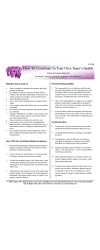Why We Don’t Include NLP Techniques In Our Discussion of Non-Verbal Behavior
Neurolinguistic Programming, or NLP, has become a common way for many non-psychologists to talk about human thinking and communication. It’s a pop psychology version. While it’s way beyond the scope of our discussion to critique NLP (since such a critique would cover many many pages and issues), it’s important for readers to understand a few things about the communication and non-verbal skills and techniques purported to be effective, and touted by both reputable and completely disreputable teachers and so called Master Practitioners.
Unlike orthodox or traditional fields, like Linguistics, Psychology, or Neuroscience, which have their roots in the academic research using controlled studies, NLP claims to focus on “what works”, and actually draws many of its techniques from other disciplines. So, while a number of the NLP techniques and statements regarding non-verbal communication may have strong research support, it’s probably also the case that some of the techniques and statements are not properly validated in controlled study environments.
The implication for casual students of non-verbal communication is that reading NLP material will expose you to some excellent and valid concepts drawn from fields like Psychology and Linguistics, but it will also expose you to concepts and statement that are not validated, or in fact, may be completely invalid. The problem is that by relying on NLP literature and courses, you won’t be able to assess what is valid and what is not.
NLP does not provide a unified theory — it’s more of a hodge-podge of things that might work.
To make things worse, NLP, unlike more academic science based disciplines relies heavily on marketing and claims, and has attracted people who are either incompetent or who’s motives are questionable. Or who might politely be called new age practitioners.
To illustrate the range of things that some practitioners include in NLP: From Linguistics, the concept or presuppositions are borrowed, certainly a valid, and accepted way to look at communication. At the other end is past life hypnotic regression, which is certainly way outside the scope of accepted scientific practice. Both are considered as part of NLP.
And, to add, you can find marketing claims and practitioners who claim they can teach you how to tell when people are lying by looking at their eye movements, and how to seduce women through the application of NLP techniques. It gets awfully messy, and it’s hard to separate the legitimate aspects of NLP from the techniques and claims made by NLP charlatans out to make a buck (or actually a lot of bucks), by preying on people’s ignorance.
All this to explain why we don’t include aspects of non-verbal behavior that are drawn primarily from NLP, and NOT found in more conventional, well researched and controlled fields. You will find, in this section, that many things discussed ARE part of NLP, but they are included because they were developed prior to, or outside of the NLP community.
So, The Caution Regarding NLP
Neurolinguistic Programming (NLP) is a field that has raised concerns due to its potential dangers. The application of NLP techniques can be misleading, as it is often associated with exaggerated claims and dubious practices. Some practitioners even claim the ability to detect lies based on eye movements or to manipulate individuals through NLP methods. These misleading tactics have blurred the line between legitimate aspects of NLP and the exploitative intentions of profit-driven charlatans. Consequently, it is crucial to approach non-verbal behavior analysis with caution, prioritizing well-researched and established fields over NLP-specific techniques and claims.






